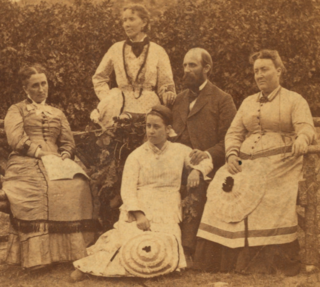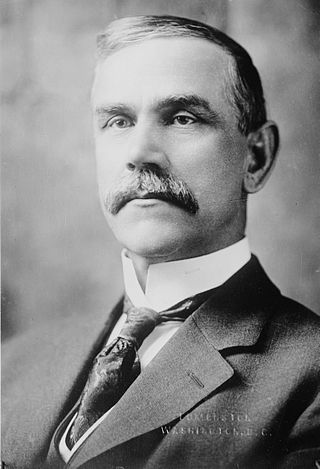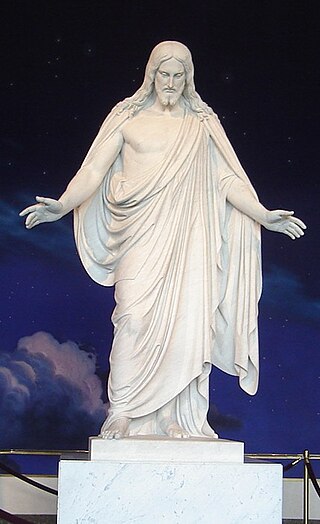Portrayal of the early LDS Church in comic art
Members of the Church of Jesus Christ of Latter-day Saints (LDS Church), also referred to as Mormons, have long been a subject of satirical humor. Illustrated anti-Mormon books and newspaper columns were commonplace throughout the United States during the 19th century. [1] : 3–6
Woodcuts
Some of the earliest forms of illustration used to poke fun at the LDS faith were the woodcuts done by Eber D. Howe. He used these cuts published in 1834 to depict tall tales surrounding the account of Joseph Smith's acquisition of the golden plates. [1] : 11 The next major anti-Mormon publication was done in 1842 and was an exposé turned book called History of the Saints, written by ex-Mormon John C. Bennett with woodcuts by F. E. Worchester and an illustration by Reverend Henry Caswall. [1] : 12–13 In 1842, Sidney Roberts published Great Distress and Loss of American Citizens in which two prints, "A Partial View of the Massacre of the Mormons" and "Mormon's leaving the city of Nauvoo, February 1st, 1846", depicted the plight of the Mormons. Soon after, more ex-Mormon publications appeared, such as An Authentic History of Remarkable Persons. As the woodcuts were not used as often, by 1847 caricatures had become more prevalent and were used to portray the Quorum of the Twelve Apostles in a book written by ex-Mormons Maria and Increase Van Deusen. Their book went through 23 editions during an 18-year period and focused on aspects of temple worship and ceremonies sacred to the Mormons and included a detailed, fold-out illustration with color. [1] : 14–16
- Print from an early anti-Mormon book depicting Mormon temple clothes and Joseph Smith inaccurately.
- Print from an early anti-Mormon book with the subtitle "The Spiritual Wife."
- Anti-Mormon illustration of the inner workings of the early Mormon temple from the Deusens's Spiritual Delusions.
In newspapers 1857–1898

In 1857, the first Mormon serial cartoons, later known as comics, emerged as part of Frank Leslie's Illustrated Newspaper and bridged the subject of how women in the Mormon militia would affect the outcome of the Utah War. [1] : 23 Other comics published that year focused on the Mountain Meadows Massacre, depicting Mormons as people who were ignorantly obedient to a cruel prophet. [2] The following year another serial cartoon appeared in Nick Nax and portrayed the family and gender dynamics in the Mormon community. The most prevalent topic for Mormon criticism in the media during this time period surrounded the newly adopted practice of plural marriage. [1] : 34 The illustrations entitled "Brigham Young the Great American Family" in Frank Leslie's Budget and "The Family Bedstead" in Roughing It, published in the 1870s, both satirised Mormon polygamy. [1] : 38–40 In 1872 a ten-panel serial cartoon in Leslie's Weekley depicted a scene in which many Mormon women sought a Japanese ambassador's hand in marriage, entitled "The Adventures of the Japanese Ambassador in Utah". [1] : 38 [1] : 38–40 Animalistic depictions of polygamy were also common. One example is The Lantern's depiction of a rooster surrounded by many hens with the caption "A foul (fowl) piece of Mormonism". [2]
Young's announcement of the implementation of the United Order in 1874 gave rise to another wave of satirical cartoons. Most of these were related to the illustrated periodical entitled Enoch's Advocate printed by anti-Mormons in Utah. [1] : 42 The Beecher-Tilton Scandal Case of 1875 inspired a resurgence of Mormon-related comics. Although this adultery case was not directly related to Mormonism, for a few years following Young's death in 1877, the magazine Puck and other print sources related that Beecher was qualified to be his successor as president of the LDS Church. [1] : 95–101
During the rest of the 1870s and continuing during the 1880s, most of the comics relating to Mormonism had ties to politics. One example depicts the many difficulties that the newly elected President Grover Cleveland would face during his presidency in the comic from Puck entitled "Foes in His Path.-The Herculean Task Before Our Next President." These problems were illustrated and the typical personification of Mormonism, which included an old bearded man with the word Mormonism written around his waist and some depiction of his many wives, was shown among them. [1] : 117
- Brigham Young and other men are shown preparing their wives for war, 1857.
- 1858 cartoon depicting Mormon women attending soldiers.
- 1858 cartoon depicting fictional officers in the Mormon army.
- 1869 cartoon: "Female suffrage: Wouldn't it put just a little too much power into the hands of Brigham Young, and his tribe?"
- 1871 cartoon of Young with his many wives and children.
- 1872 cartoon of the Japanese ambassador visiting Utah meeting Young's wives and children.
Mormons and racial minorities
In 1879, The Wasp introduced the comparison of the Mormons with other groups such as Chinese, blacks, Native Americans, and Irish in a cartoon portraying Uncle Sam kicking said groups out of his bed. [1] : 75 Many similar cartoons depicting Uncle Sam and his annoyance with the diverse religious and ethnic groups that resided in the United States were created during this period. [1] : 81 Another way in which the media portrayed Mormons was by combining aspects of the Mormon and Catholic faiths, such as dressing a Mormon man in the religious clothing of the Catholic faith. [1] : 84 Many times blacks were portrayed in Mormon polygamist families. [1] : 85
According to historian W. Paul Reeve, by the early 1900s, with the intense media coverage of the Reed Smoot hearings, such images became "part of an effort to trap Mormons in a racially suspect past even as Mormon leaders attempted to shape a whiter future." Mormons were keenly aware of the racial slight:
Outsiders suggested that Mormons were physically different and racially more similar to marginalized groups than they were to white people. Mormons responded with aspirations toward whiteness. It was a back-and-forth struggle between what outsiders imagined and what Mormons believed. The process was never linear and most often involved both sides talking past each other. Yet, Mormons in the nineteenth century recognized their suspect racial position.
— W. Paul Reeve, in Religion of a Different Color: Race and the Mormon Struggle for Whiteness (Oxford University Press, 2015) [3]

In newspapers 1898–1909
Between 1905 and 1909, The Salt Lake Tribune included over 600 cartoons relating to Mormonism. [1] : 57 Related images were beginning to be produced in not only newspapers and magazines, but in pamphlets, periodicals, and more illustrated books. The Mormon leader and politician B. H. Roberts was elected to Congress in 1898, which put the LDS church in the spotlight once again and the fact that Roberts practiced polygamy caused many problems for him, his family, and the other Mormons still engaged in polygamist relationships. The Salt Lake Tribune and many other media outlets had a field day after discovering that one of Roberts' plural wives had just given birth to twins. [1] : 61

A similar reaction occurred in the press when Reed Smoot was elected to the U.S. Senate in 1903. [1] : 65 For the next three years, many cartoons and comics were created surrounding Smoot's office. [1] : 65 One of the most iconic of these sketches was "What They Expected at Washington" created by the cartoonist Lovey, which shows a train with one car for husbands, many more cars for wives, and then continuing off into the distance are the train cars full of Mormon children. [1] : 65–66 The anti-Mormon sentiment in The Salt Lake Tribune was fueled by its owner, Republican senator Thomas Kearns. [4] Although Kearns and Smoot were initially friendly, according to Michael Paulos, Smoot's political success came at a cost of Kearns's, and Kearns hired ex-Mormon Frank J. Cannon to edit the Tribune. Cannon's extreme anti-Mormonism, as reflected in the Tribune at the time, was noted sarcastically by non-Mormons: "How proud we Gentiles are of our self-constituted champions in the fight the Tribune is making on the Mormons!" [4]

In 1904, after Smoot was officially seated in the Senate, the national media's intense interest in Mormonism slowly declined and because of new forms of communication and transportation people were able to learn more about the Mormons on a personal level instead of relying on the information provided in the comics of the daily newspaper. [1] : 71
Many popular comic depictions included Mormon women who were impoverished, uncultured, hideous, unfaithful, overbearing, and overworked slaves to their husbands. They were also often depicted as being members of a harem and being part of a lustful marital lifestyle. [1] : 127–128 During this time in history most women were portrayed in a negative light in the media, but because of the controversy of polygamy in Mormon culture, the amount of ridicule that Mormon women received was far worse than that received by their non-Mormon counterparts. [1] : 136


















